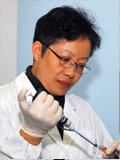
Director of Department of Pharmacology Ⅱ,PI,Ph.D candidate supervisor
Center for Neurological and Psychiatric Research and Drug Discovery (CNPRDD)
Personal Homepage
CONTACT
lyfeng@simm.ac.cn
021-50806810
201203
555 Zu Chong Zhi Road , Zhang Jiang Hi-Tech Park, Pudong, Shanghai
FENG Linyin obtained her Ph.D. in Shanghai Medical University in 1991. She jointed Shanghai Institute of Brain Research as a postdoctor. In 1997, Feng was promoted to the professor. She undertake a number research projecsts from National Basic Research Program of China, National Basic Research Program of China and published more than 40 papers in the international academic journals.
EDUCATION
1991 Ph. D.,Dept. of Histology and Embryology,Shanghai Medical University
1985 Master Degree for Sciences,Dept. of Anatomy,Jiangxi Medical College
1982 M.D.,Dept. of Medicine,Jiangxi Medical College
WORK EXPERIENCE
Postdoctoral Training:
02/1992 - 07/1994 Postdoctoral Fellow,Shanghai Brain Research Institute,Chinese Academy of Sciences
Advanced Training:
02/1994 - 06/1994 Dept. of Biochemistry,Hong Kong University(Training program of International Brain Research Organization)
Academic Appointments:
04/2004 - present Professor,Shanghai Institute of Materia Medica,Chinese Academy of Scineces
11/1999 - 03/2004 Principle Investigator,Head of Molecular Neurobiology,Institute of Neuroscience,Chinese Academy of Sciences
05/1999 - 11/1999 Professor,Shanghai Brain Research Institute,Chinese Academy of Sciences
07/1994 - 04/1999 Associate Professor,Shanghai Brain Research Institute,Chinese Academy of Sciences
01/1987 - 12/1988 Lecturer,Department of Anatomy,Jiangxi Medical College
01/1983 - 12/1986 Teaching Assistant,Department of Anatomy,Jiangxi Medical College
(1) Study on the role of glia cells in pathological and pharmalogical action process of brain ischemic and Parkinson's disease
(2) Study on the epigenetic regulation in brain ischemic and Parkinson's disease
2. Screen and discovery small molecule compounds for regulating of proliffiration and differentiation of neural stem cells and mesenchymal stem cells
2.the National Science and Technology Major Projects for “Major New Drugs Innovation and Development",The study of leading compounds for treatment of neural diseases based on neuroglia-targeting,Head,2014.01-2016.12
3.the National Science and Technology Major Projects for “Major New Drugs Innovation and Development",The study of anti-stroke drug candidates isolated from Paeoniae Radix,Head,2009.01-2010.12
4.the Scientific Innovation Project of the Chinese Academy of Sciences,Study of small molecues for regulating differentiation of neural stem cell,Head,2011.01-2015.12
2001 - present Member of Council of Shanghai Society for Cell Biology
1997 - 2004 Member of Council of Shanghai Society of Physiology
1998 - 2001 Secretary-General,member of Standing council of Shanghai Society for Neuroscience
2007 - present Member of Council of Chinese Pharmacology Society
Full Publication List
Selected Publications
1.Zhang Y., Wu Q., Zhang L., Wang Q., Yang Z., Liu J., Feng L.* Caffeic acid reduces A53T α-synuclein by activating JNK/Bcl-2-mediated autophagy in vitro and improves behaviour and protects dopaminergic neurons in a mouse model of Parkinson’s disease. Pharmacological Research. 2019 Dec;150:104538. doi: 10.1016/j.phrs.2019.104538. Epub 2019 Nov 9.
2.Hong F., Zhao MX., Zhang L., Feng L. * Inhibition of Ezh2 in vitro and the decline of Ezh2 in developing midbrain promotes dopaminergic neurons differentiation through modifying H3K27me3. Stem Cell and Development, 2019, 28(10) :649-658
3.Yu X., Cheng G., Zhang L., Zhang Y., Wang Q., Zhao M., Zeng L., Hu Y*., Feng L.* N-Phenylquinazolin-2-amine Yhhu4952 as a novel promotor for oligodendrocyte differentiation and myelination. Sci Rep. 2018 Sep 19;8(1):14040. doi: 10.1038/s41598-018-32326-0.
4.Lu H., Cheng G., Hong F., Zhang L., Hu Y., and Feng L.* A Novel 2-Phenylamino -Quinazoline-Based Compound Expands the Neural Stem Cell Pool and Promotes the Hippocampal Neurogenesis and the Cognitive Ability of Adult Mice. Stem Cells. 2018 Aug;36(8):1273-1285. doi: 10.1002/stem.2843. Epub 2018 May 12.
5.Wu Q., Yang X., Zhang L., Zhang Y., Feng L* Nuclear accumulation of histone deacetylase 4 (HDAC4) exert neurotoxicity in models of Parkinson’s disease. Molecular Neurobiology 2017 54:6970–6983 DOI 10.1007/s12035-016-0199-2
6.Yang X., Wu Q., Zhang L., Feng L* Inhibition of Histone Deacetylase 3 (HDAC3) Mediates Ischemic Preconditioning and Protects Cortical Neurons against Ischemia in Rats. Frontiers in Molecular Neuroscience 2016, (9): 131
7.Zhang N, Zhang L, Feng L*, Yao L. The anxiolytic effect of essential oil of Cananga odorata exposure on mice and determination of its major active constituents. Phytomedicine. 2016 Dec 15; 23(14):1727-1734. Epub 2016 Oct 27.
8.Wu Q., Yang X., Zhang Y., Zhang L., Feng L* Chronic mild stress accelerates the progression of Parkinson's disease in A53T α-synuclein transgenic mice. Experimental Neurology 2016, 285 61–71
9.Sun Y., Hong F., Zhang L. Feng L.* The sphingosine-1-phosphate analogue, FTY-720, promotes the proliferation of embryonic neural stem cells, enhances hippocampal neurogenesis learning and memory abilities in adult mice. British Journal of Pharmacology 2016, 173 2793–2807
10.Jin L, Zhang LM, Xie KQ, Ye Y, Feng L*. Paeoniflorin suppresses the expression of ICAM-1 in endotoxin-treated human monocytic cells. Br J Pharmacol. 2011, 164: 694–703. [Epub ahead of print]Back




